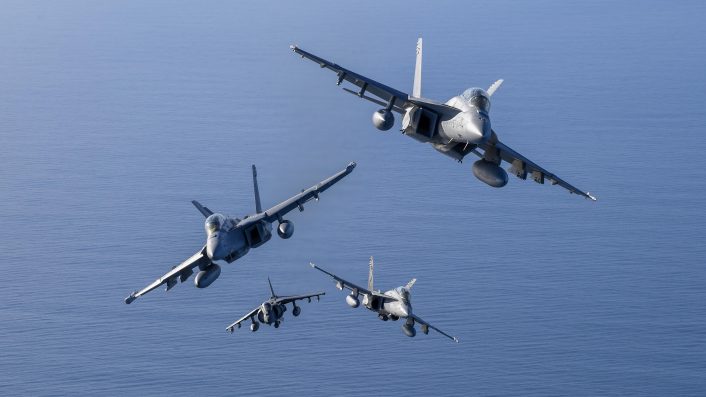NAWCAD is seeking sources to add Automatic Ground Collision Avoidance System (AGCAS) to the F/A-18E/F Super Hornet and EA-18G Growler.
The U.S. Navy is starting the preliminary work for the integration of an Automatic Ground Collision Avoidance System (AGCAS) capability on the F/A-18E/F Super Hornet and EA-18G Growler. The news, first reported by the Aviation Week, highlights the service’s effort to increase the safety of its platforms, protecting the aircrews against errors and incapacitation.
AGCAS Integration
The Naval Air Warfare Center Aircraft Division (NAWCAD) released a sources sought notice on Nov. 10, 2025, in support of PMA209 Air Combat Electronics Program Office. According to the notice, as part of the Tactical Aircraft Moving Map Capability (TAMMAC) program, the service is looking for “a software solution to integrate and redesign the Digital Map Computer (DMC)/Digital Video Map Computer (DVMC), and Flight Control Computer (FCC) in support of the F/A-18 E/F & EA-18/G Automatic Ground Collision Avoidance Systems (AGCAS) program.”
“Avionics upgrades to Naval Aviation platforms are required to ensure compliance with current safety and airworthiness requirements,” says the service. In the fiscal year 2026 budget request the Navy noted Auto GCAS is a “significant safety improvement that could have prevented multiple fatal F/A-18 mishaps over the past two decades.”
Specifically, “the redesign will integrate a new Automated Terrain Awareness Warning System (ATAWS) software module and Interface Design Document (IDD). The Super Hornet already have a Terrain Awareness Warning System (TAWS) which alerts the pilot of potential Controlled Flight Into Terrain (CFIT) risks, hosted in the DMC and DVMC.

The current system only alerts the pilots of potential CFIT incidents and provides guidance to avoid them. The upgrade would now automate that, allowing the aircraft to automatically recover from potential CFIT, which is extremely useful in the event the pilot is incapacitated.
Aviation Week noted how both stakeholders and lawmakers have called on the Navy to install an Auto GCAS system. The effort was also part of the House’s version of the fiscal 2026 defense policy bill, with lawmakers requiring the Navy to outline an acquisition approach by March 2026.
AGCAS Usefulness
Apart from human errors such as target fixation, there are some situations in which AGCAS would be critical to save both the aircraft and the crew. These are Spatial Disorientation and G-induced Loss Of Consciousness (GLOC).
Spatial Disorientation is the inability to determine one’s position, location, and motion relative to their environment. This can happen not only in fighter jets, but in every type of aircraft, both military and civilian.


A situation that commonly causes Spatial-D is the flight in Instrument Meteorological Conditions (IMC), where bad visibility conditions would prevent a pilot from using external reference points and, in some cases, his senses would stop to “agree” with the current attitude of the aircraft. For an instance, the pilot’s senses could be tricked to think the aircraft is in level flight, while in reality it is in an inverted dive.
GLOC could happen during maneuvers with high g-loading, which draw blood away from the brain and towards the lower part of the body. GLOC is not completely sudden, as it is preceded by tunnel vision, greyout and blackout.
While the earlier phases would only see a pilot temporarily visually impaired, GLOC is a complete incapacitation. According to statistics, this incapacitation averages 12 seconds, followed by 15 seconds of recovery from the event.
In those cases, AGCAS would take over the controls and recover the aircraft to avoid a collision with the terrain. Usually, this would include the computer rolling to wings-level and then pulling up, away from the terrain.
The system includes of complex algorithms that utilize precise navigation, aircraft performance and on-board digital terrain data to determine if a ground collision is imminent. The AGCAS software is executed in the background, ready to take over at a moment’s notice.
In 2022, the U.S. Air Force said AGCAS has been credited for saving 12 F-16s and three F-22s from crashing, with spatial disorientation being the most common cause for the dangerous attitude that triggered the automatic recovery. The service also says CFIT incidents account for 26 percent of aircraft losses, highlighting how a technology such as AGCAS could be important to improve the safety of flight.

